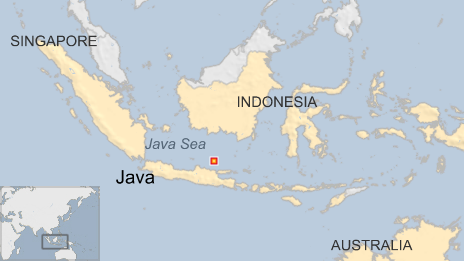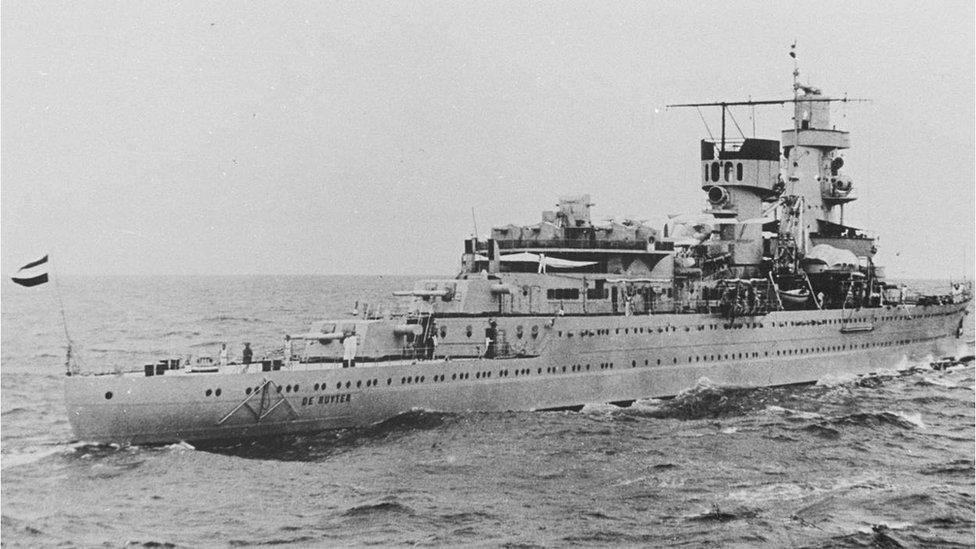How could a shipwreck disappear?
- Published

The ships sank in 1942 in a remote part of the Java Sea
Dutch and British World War Two shipwrecks have mysteriously disappeared from the Java Sea, prompting outrage. The BBC asks experts what could have happened to the vessels.
For decades the wreckages of three Dutch warships - HNLMS De Ruyter, HNLMS Java and HNLMS Kortenaer - were lost to the world, sitting at the bottom of the Java Sea.
The victims of a fierce 1942 sea battle with the Japanese, the ships had gone down along with 915 Dutch and 259 Indonesian sailors.
Their 2002 discovery by amateur divers was a cause for celebration, and the ships were declared war graves.
But now it seems they have been lost again - possibly permanently - with the Dutch government confirming this week that the ships have vanished from the seabed. The Indonesian navy is investigating.
In Britain, the Guardian newspaper reported, external that three UK warships that had been sunk in the same battle had disappeared as well.

HNLMS Java was one of three Dutch ships lost
Sold for scrap?
There is now suspicion that the ships were stolen and sold as scrap metal, a commonplace practice in a region that is littered with old wrecks.
The diver who found the wrecks intact in 2002, Vidar Skoglie, told Dutch broadcaster, external NOS that he believed Indonesians had towed the ships to the port-city of Surabaya for demolition - although this theory was disputed, external by an expedition team that recently visited the site.
The three ships were located 100km (60 miles) off the Java coast at a depth of between 60 and 70m.

Ship salvage experts told the BBC that any attempt to raise and tow huge ageing warships from such depths would be a massive operation involving multiple barges, cranes and trained divers.
This raises the question of how the ships could have been taken without authorities noticing - though some have pointed out that Indonesia has a vast coastline, and its navy and coast guard have limited resources.
'Nibbling away'
What was more likely was that locals clandestinely stripped the wrecks in a piecemeal fashion over the years until nothing was left.
Bas Wiebe, commercial manager of salvage company Resolve's Asia operations, said they could have cut away parts of the rotting wreckage using mechanical equipment known as grabs.
"If time is not of the essence, you have a barge and equipment, you could just nibble away," said another expert who declined to be named citing political sensitivities.

HNLMS De Ruyter had 345 men onboard
Another possibility is that the ships were blown up into smaller pieces - a cheaper and faster way to disintegrate wrecks.
"It is not like an huge explosion like you see on TV. It's basically fairly contained but enough to break apart the vessel and if you do it a few times, you can just fish out the pieces," said Mr Wiebe.
But one expert disputes this theory citing a lack of debris surrounding the ships' imprints on the seabed.
"Using regular explosives would create a debris field, and an even bigger one if ordnance remaining onboard exploded as well," said Arnab Chakravorty, from ship salvage firm Ardent Asia-Pacific.
Some experts raised the possibility that heavy storms, shifts in tectonic plates, or even the 2004 Indian Ocean tsunami may have caused the ships to drift to a different location.
Mr Wiebe cast doubt on that theory given the ships' depth and duration spent at the bottom of the sea.
"Over the decades the ships would have filled up with sand, so they would be even heavier now. Even if they moved, they wouldn't have shifted very much," he said.
What is certain is that the Dutch have lost an important part of their maritime history - and it remains to be seen whether the ships can ever be found again.
- Published16 November 2016
